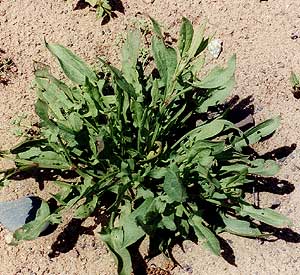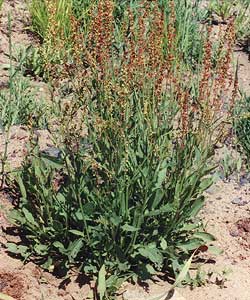
Sheep Sorrel
Children love sheep sorrel. Somehow, thousands of children across the country have learned to eat sheep sorrel without being instructed by any adult. And once they learn, they pass it on to each other. It spreads like wildfire. Parents, unless they, too, knew sheep sorrel as a child, gasp in horror to see their green-tongued children merrily grazing on "sour grass" in the front yard. Fear not. Examine the plant: if it looks like sheep sorrel, and it tastes like sheep sorrel, and the kids say they've always eaten it, then it is sheep sorrel, and you ought to join the fun.
Many parents are afraid to let their children gather wild edibles with them, for fear that they will misidentify plants and poison themselves. I have found, however, that once properly shown an edible plant, children over eight seem to have an incredible aptitude for recognizing the plant again. This makes perfect sense, for children must have regularly accompanied their mothers in the harvesting of plants over the long history of human beings. I don't know what age is too young, but I was actively foraging on my own at six years old.
Last summer I led a wild food collecting trip for a boy's camp in Northern Wisconsin. In less than an hour I showed nine kids, ranging from ten to twelve years of age, about thirty species of wild edibles. Sheep sorrel, gooseberries, and sumac berries were a real hit. I returned two weeks later to lead a much larger group, including most of those on the first trip, plus all of their friends. I was delighted to discover that not only did every participant from the last expedition remember several plants, but the veterans had already taught the new kids how to identify several species, and they had made sumac-ade and gathered sheep sorrel and some berries on their own time. One boy in particular remembered every single plant I had showed on the last trip, and recited the identifying characteristics perfectly.
 "Sheep sorrel. Succulent leaves that look like an arrowhead. Reddish-brown
flowers on the mature plant. The leaves have tiny sparkles when you hold
'em up to the sun." The old kids actually warned the new kids of dangers.
"You can eat the tips of grape vines, but not five-leaved ivy. Look over
here! This is five-leaved ivy. You can't eat the berries, either. It looks
way different." These kids weren't experts; they just paid attention. And
I bet they'll never forget sheep sorrel. I sometimes wonder if we actually
lose our aptitude for identifying plants as we age.
"Sheep sorrel. Succulent leaves that look like an arrowhead. Reddish-brown
flowers on the mature plant. The leaves have tiny sparkles when you hold
'em up to the sun." The old kids actually warned the new kids of dangers.
"You can eat the tips of grape vines, but not five-leaved ivy. Look over
here! This is five-leaved ivy. You can't eat the berries, either. It looks
way different." These kids weren't experts; they just paid attention. And
I bet they'll never forget sheep sorrel. I sometimes wonder if we actually
lose our aptitude for identifying plants as we age.
Characteristics
One of the things that I like about scientific names is that they help demonstrate the relationships between plants. For example, I had eaten sheep sorrel greens for a few years, relishing their delicious tartness, before I noticed that the Latin name of this plant is Rumex acetosella. It stood out to me because Rumex is the genus of docks, and I had never thought of sheep sorrel as a dock. It is so much smaller and more delicate than other docks, with leaves of a wholly different texture. While some docks have leaves which are fairly good to eat when still very small, they all become unpleasantly pungent and bitter with age. All except for sheep sorrel, of course; sheep sorrel is a special kind of dock.When compared by characteristics other than taste and size, the similarities between sheep sorrel and other docks are striking, and it becomes apparent why they are classified in the same genus. All of them are biennial or perennial, having a basal rosette of stalked leaves. All of them send up sparsely-leaved stalks during flowering years, and a papery sheath clasps the stem near the petiole of each stalk leaf. Most importantly, the flower and fruit structures of all are nearly identical in form. Sheep sorrel is indeed a dock - just a very, very small one.
Sheep sorrel is one of the most accessible wild edibles in North America. It grows from coast to coast, Canada to Mexico, and is equally at home in the wilderness and the front yard. It likes sunny sites that are sparsely vegetated, especially where the soil consists of sand or gravel. Sheep sorrel seems to have a definite preference for acidic sites. Although this herb needs well-drained soil, its moisture requirements prevent it from growing in arid areas. The best places to find sheep sorrel are old fields on sandy soil, roadsides, gravel and sand pits, and naturally bare sites such as steep slopes, beaches, and banks. Sheep sorrel is abundant in pine-oak barrens of the Great Lakes Region. I have seen large, healthy patches of it in gardens, agricultural fields, and yards, as well as in places far from recent disturbance. It spreads by rhizome as well as by seed and is considered a pesky weed by many. A close relative, the garden sorrel Rumex acetosa, is considered a gourmet vegetable. Sheep sorrel is just as gourmet, however, to those of us who recognize it.
As a youngster I often read about sheep sorrel and pored over drawings of the plant, making mental notes of its features so that I could recognize it when I finally encountered it in the flesh. I noted the arrowhead-shaped, lopsided leaves with flares at the base, the branching clusters of tiny green and reddish-brown flowers. What I failed to take note of, however, was the overall size: rarely over a foot tall, with leaves normally 1 1/2 to 2 1/2 inches in length. I was looking for a much larger herb, and so for years never identified sheep sorrel, though I was treading over and upon it almost daily. When I finally keyed this plant out on a roadside in one of Wisconsin's "sand counties," I whooped with joy. From then on the plant has seemed to be everywhere.
Using Sheep Sorrel
The part of sheep sorrel that is used for food is the leaf; the stems and leaf stalks are generally too tough, and the flowering parts are small and slightly bitter. Sheep sorrel leaves do not become unpleasantly tough and bitter with age as most greens do, which means that they can be gathered from spring to fall. This makes it a good plant to know.
The leaves are rather succulent but not thick like those of purslane. They are arrowhead-shaped, but they bulge toward the end, and unlike other herbs with a similar leaf shape, the leaves of sheep sorrel are usually notably lopsided. When they first appear in spring, the tiny leaves of this plant are dark brownish-red. These early red leaves are not palatable, but they are too small to bother with anywise. If sheep sorrel sprouts from seeds in the summer, the leaves do not have the typical flares at the base (i.e. they are not arrowhead-shaped.) Instead, they are simply spoon- shaped. It is hard for beginners to recognize them in this form.
Gathering sheep sorrel is pretty straightforward: pick the leaves. When you cook this green, it shrinks to an almost absurd degree, so gather a lot - and that still might not be enough. Of course, you don't have to cook it; sheep sorrel is excellent on sandwiches, in salads, or just to nibble while you're out walking.
The flavor of sheep sorrel is very sour. Most people are a little shocked the first time they taste this plant, because it packs an unexpected punch. The tartness is due largely to a high concentration of oxalic acid. (You may have heard warnings about the danger of consuming too much oxalic acid. That is addressed in a following article.) Although sheep sorrel is not likely to be the main course in anybody's dinner, it has a wide range of culinary applications due to its pleasing tartness.
Most of us douse our salads with vinegar (among other things) to give it some sourness. Sheep sorrel leaves can be used to replace some or all of this vinegar - although the flavor will not be the same. Dishes such as rice or cous cous can be bland and boring without a touch of tartness. Traditionally we might employ dried tomatoes to add the desired flavor, but sheep sorrel leaves will work marvelously in this capacity. Did you ever notice what all condiments and sauces have in common? That's right - they are sour. A recent issue of The Wild Food Adventurer (Vol.6 No.4) contained a recipe for a sheep sorrel sauce for meats and vegetables by John Kallas. With a little experimentation you can invent your own sauce, or follow John's recipe.
In my own kitchen the most important use of sheep sorrel is as an ingredient in soup. Every good soup must have an appreciable amount of the three basic soup flavors: sweet, salty, and sour. It is amazing what a handful or two of sheep sorrel greens does for a soup that is lacking that certain je ne sais quoi. I have not tried drying sheep sorrel greens, but I am going to this year, because every winter I find myself wanting them in the kitchen.